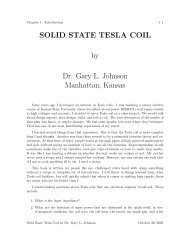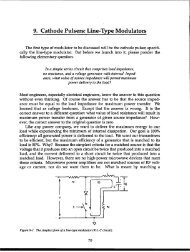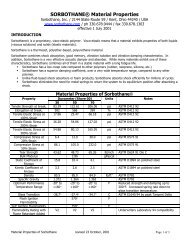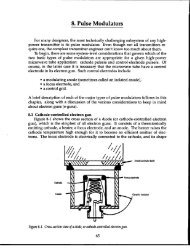3.6M north10.pdf - Dean-O's Toy Box
3.6M north10.pdf - Dean-O's Toy Box
3.6M north10.pdf - Dean-O's Toy Box
Create successful ePaper yourself
Turn your PDF publications into a flip-book with our unique Google optimized e-Paper software.
Cathode Pulsers: Hard-Tube Modulators (10) 193<br />
capacitance. The fall time, however, cannot be reduced by anything that can be<br />
done to or with the switch tube. When shorter fall time is required, a “tail-biter”<br />
or “active pull-up” stage is usually employed. (This featuw was illustrated in<br />
Fig. 2-1, the transmitter block diagram.) This device, usually another switch<br />
tube, is connected between the diode-gun cathode and ground and is pulsed into<br />
conduction only during the desired fall time of the pulse. Its current adds to the<br />
ever-diminishing current of the diode load to facilitate discharging of the stray<br />
capacitance. A constant-current tail-biter of current I will produce a fall time, At,<br />
that is no longer than AV x C~/1,where AV is the pulse voltage amplitude, even if<br />
the diode-load current is negligibly small.<br />
In the case of grid-driven tiiode switch tubes, which include the modulatinganode<br />
type of tube as well, there is another aspect to rise-and-fall time: the effect<br />
of “Miller” capacitance, which is related to the capacitance between anode and<br />
control grid. Miller capacitance and the capacitance between grid and cathode<br />
make up the static input capacitance of a triode. With the anode comected to a<br />
fixed voltage source, the rate at which the voltage between grid and cathode can<br />
be varied depends upon the driver stage’s source resistance, or current-delivery<br />
capabili~, and the sum of the two input capacitance components. The anode,<br />
however, is usually not connected to a fixed voltage. It is connected to the load,<br />
and the load-voltage excursion is the same as the anode-voltage excursion. The<br />
change in charge, or AQ, experienced by the anode-grid capacitance is not the<br />
product of the grid-voltage change times anode-grid capacitance but is the anode-voltage<br />
change times the anode-grid capacitance. In effect, the anode-grid<br />
capacitance component of total triode input capacitance is multiplied by the<br />
voltage gain of the triode. This fact must be considered in the design of a grid<br />
driver. Moreover, the internal impedance of the driver stage in both directions<br />
must be considered. This is because all amplifiers that have a single active device<br />
have source impedances that are different, depending on whether the device is a<br />
source or a sink for output current. For this reason, active pull-up/active pulldown<br />
pairs connected in a “totem-pole” configuration are the preferred grid<br />
driver stages in critical rise-and-fall-time applications. This is because they can<br />
be designed to deliver equal output currents in both directions.<br />
With high-voltage and high-current transistors now availabl~specially the<br />
metal-oxide semiconductor field-effect transistor (MOSFET)-triodes do not have<br />
to be grid-driven. They can be cathode driven by what is often called the<br />
grounded-grid, or grid-separation, connection. The control grid can be connected<br />
to a fixed source of positive grid bias, if necessary. A typical cathode-drive<br />
connection is shown in Fig. 10-33. During the switch tube’s interpulse (or off)<br />
state, the MOSFET is in the off state. To reduce cathode current to the same value<br />
as the MOSFET’S drain-leakage current, which is negligibly small, the drain of<br />
the MOSFET will automatically assume whatever positive voltage is required,<br />
including an amount equal to whatever positive voltage is applied to the grid.<br />
No negative grid bias supply is needed at all. To cause output current and load<br />
voltage, the cathode MOSFET is turned on, pulling the switch-tube cathode to<br />
within a few volts of ground (or deck) potential. The effective grid-cathode<br />
voltage at this time is whatever positive voltage source is connected between<br />
grid and ground. The “Miller” charge and discharge currents flow either into the







